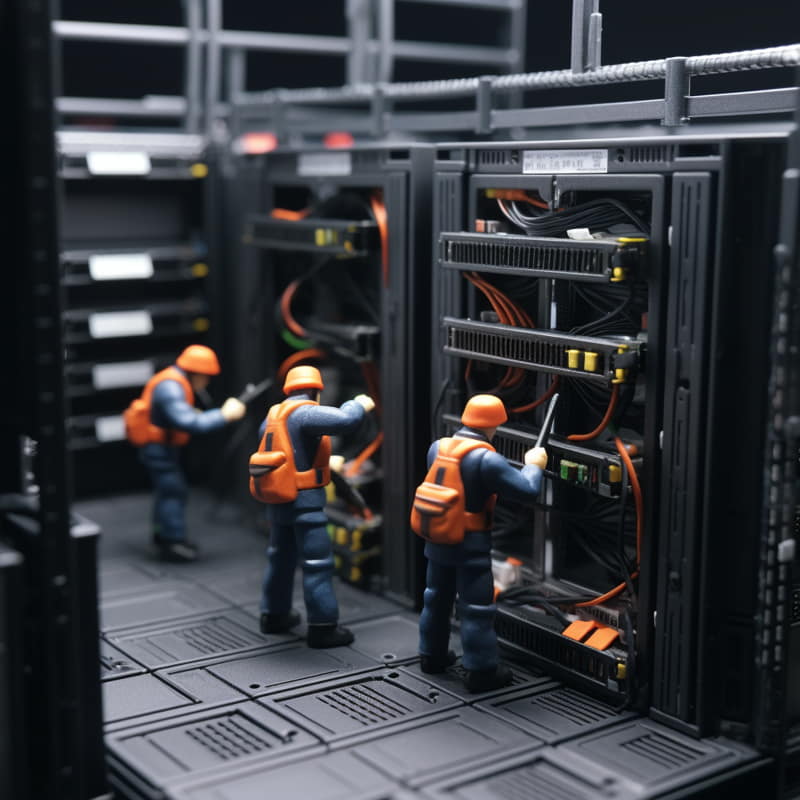Network Administrator Interview Questions and Answers
Network administrators need in-depth knowledge of technology and comprehension of networking protocols, hardware, and software to maintain company or organisational networks effectively.
As a network administrator, technology is continuously transforming. No matter your level of experience in this profession or how long you’ve been practicing it.

1. What is Netstat?
Netstat is a command-line network utility tool that displays network connections for TCP and IP protocols, routing tables, network interface statistics, and protocol stats.
2. What is the Netstat command used for?
This command displays all network interfaces on a computer, allowing one to understand better which interfaces are currently active on that particular machine.
3. What is the R command used for?
This command displays the current routing table, which details all destinations, gateways, and gen masks, helping one understand a network’s different sizes.
4. How easy is it to use Netstat?
Thanks to its straightforward command-line interface, Netstat is easy to use; we explore some essential commands that simplify life.
5. Why is it important to understand the routing table?
Understanding the routing table is critical because it lists all destinations, gateways, and gen masks of an IP network’s various sizes; additionally, it helps troubleshoot any network-related issues while managing network traffic more effectively.
6. How do you list all active connections with the Netstat C command?
For this task, type Netstat, a. This will list all currently active, established connections sorted by protocol name/ID number/namespace and state.
7. What is the purpose of sorting data with the Netstat C command?
Sorting data through this command gives a comprehensive view of network connections and protocol statistics, such as TCP/IP connections or UDP ones with active connections.
8. What is the local address in the Netstat C command output?
The local address gives administrators insight into which ports are running on their local host computer; this helps monitor network activity and pinpoint issues specific ports may present.
9. What does the foreign address indicate in the Netstat C command output?
A foreign address signifies a connection currently running on a host and waiting to connect; it enables administrators to monitor network activity and address potential problems regarding inbound connections.
10. What does the established state show in the Netstat C command output?
This data displays any external IPs accessing websites via HTTP, and this helps administrators monitor network activity and troubleshoot problems related to specific websites or applications.
11. How can I use the netstat command to filter data?
Netstat can filter data based on specific protocols and states; for instance, using active connections command with T protocol for TCP connections while U protocol displays UDP/IP connections can filter them accordingly.
12. What is the difference between TCP/IP and UDP/IP?
TCP/IP is a connection-oriented protocol that creates a secure channel between devices before transmitting data, it is commonly used for applications requiring error-free delivery, such as email, file sharing, and web browsing.
UDP/IP provides data transmission without creating connections; its main advantage over its counterpart lies in the speed of data delivery over any given connection – ideal when dealing with applications that rely on reliable delivery, such as emails.
13. What is the OSI model?
The Open System Interconnection Model, commonly called OSI, provides a conceptual framework for explaining how networking or telecom systems function. Its seven layers cover Physical Linking, Networks Transport Session Presentation, and Application systems.
14. What is NetBIOS?
NetBIOS is a network protocol suite for communicating between devices on a Local Area Network. Typical applications of this protocol suite include file and printer sharing and low-level file and printer access applications.
15. How can I display the listening UDP ports?
Utilise the stat command to display UDP ports listening by entering output and searching grep for specific results.

Network Administrator Training

The AT and AP commands display all TCP connections and their process IDs; A T P will also show this data.
17. What is the purpose of using the nets that ATP commands?
ATP commands are designed to give a deeper insight into what services are running on your computer, by entering “ATP, ” various services with your process ID running will appear, providing a better picture of what your PC is up to, how it connects with the Internet, and which services are running.
18. What is the purpose of typing the Netstat command in Netstat?
Typing in Netstat lets you view only listening connections and services currently set to attend, clearly showing which services are running on a network.
19. How can you find the port number of a particular service using Netstat?
Netstat can use its NLP command to determine any particular port quickly.
20. What does Netstat show when it monitors TCP and IPv6 services?
Netstat provides a complete overview of services running TCP/IPv6 when monitoring these protocols.
21. What are the functions of Netstat?
Netstat is an essential network protocol tool designed for system and network administrators that offers various options to understand what’s currently running on computers; its useful features enable an organisation’s computer network to stay current by providing insights into TCP connections on individual machines and how well these may function as intended.
22. What are the roles and responsibilities of a network administrator?
A network administrator’s primary responsibility in India involves keeping an organisation’s computer network updated, functioning as intended, and following company protocols – particularly for companies utilising multiple computers and software platforms.
Managers in IT roles need to coordinate and connect various systems, perform troubleshooting and problem-resolution activities, manage cloud and physical network environments, and oversee cloud stories.
23. What non-technical abilities benefit a network administrator?
Nontechnical abilities that may benefit a network administrator include analysing and critical thinking skills, time management techniques, and interpersonal abilities.
Network administrators must efficiently manage multiple players, people, and problems while maintaining balance and organisation.
24. How do you obtain the command window?
You can launch the command window by selecting Start then Run, entering CMD as part of a text field, clicking OK, or going directly into All Programs Accessories, Command Prompt from the Start Menu.
25. What is Charlie Delta, and how can it help in the command window?
Charlie Delta is a command that can be typed into the command window to organise CD into C, D, and then space, with backslashes after them, to access the C Drive root folder. Press CLS + Enter, and your screen will clear instantly!
26. What is the command “netstat”, and what flags can be used with it?
Netstat displays protocol statistics and current TCPIP network connections; various flags can be used with it; here, I’ll focus specifically on dash B.
27. How do you output net stats output to a text file?
To achieve this goal, use the old DOS command-line function “greater than” followed by your file name; for instance, if performing netstat dash B space, then more significant than will create a file called “netstat dot txt presenter.”
28. How do you begin the program?
Start the program by typing “CMD”, followed by this command: deck any state space forward slashes question mark.
29. What is the purpose of the switch?
The switch clears your screen by showing which TCPIP and UDP ports are utilised.
30. What is the function of the B switch?
The B switch displays an overview of all active rules on your system, such as active connections using executable files.

Network Administrator Online Training

31. What is Net Start, and what does it do?
Net Start is a command-line utility that displays network connections such as open ports and connections with remote hosts on different operating systems such as Windows, Mac OS and Linux; using Net Start’s interactive display features, users can see details regarding printers connected locally as well as web servers out on the internet – such as printers.
32. What is Net Start output?
Net Start output depicts the state of each connection; these could range from active connections, waiting for computers or long-standing; as more connections come online, more entries appear in Net Start.
33. What command can list all connections, including executable names and unique process IDs?
Users looking to compile an exhaustive listing can run either of the “netstat dash b, ” “o, ” or “trustee n” commands.
34. How does the “trustee n” command improve the output of the “netstat” command?
Trustee n is an add-on command that shows all connections without translating host names, thus improving output speed and accuracy.
35. What is the default route in a computer’s routing table?
A computer’s default routing table route is zero dot zero dot zero, with its gateway being 192.168.1.254.
36. What is the purpose of the Netstat Utility?
Netstat Utility is a command-line program showing network connections and port activity on any computer or server. It helps users identify which services are running and which ports are open and provides insight into which ports may require attention regarding network activity.
37. What is the output of Netstat with a minus and switch?
Assuming you know where and what Netstat stands for, adding “-” will show the same output but only numbers; DNS must resolve them into names, which takes time and thus delays its production; however, it only temporarily displays computer names and IP addresses.
38. How can we combine switches to get the desired output?
Using all relevant switches, we can combine switches for our desired output; for instance, by connecting only the last two switches, we can see both programs run from the B switch, fully qualified domain names from the F switch simultaneously or use A and N together and view currently active connections and listening ports using the A switch.
At the same time, its instantaneous output only shows numbers instead of names produced by the N switch.

Put your knowledge through its paces by taking these multiple-choice quizzes.
39. What is the default gateway shown in the net stat R command?
ENMP 1SO interface
Active connections and services
The destination
Network interfaces and protocol statistics
40. What information does the netstat command display by default?
TCP/IP, UDP, and other protocol statistics
Network interfaces and protocol statistics
Active connections and services
ENMP 1SO interface
41. What is the state of most connections in the OSI model?
Established
Listen
Non-existent
Connected
42. What protocol is used for TCP/IP connections?
TCP
UDP
IP
HTTP
43. Which of the following is an example of a service that runs on port 443 using Netstat?
SSH
HTTP
FTP
Telnet
44. What command can be used to access the UDP command?
UNL
UDP
TCP
IP
45. How can you quickly sort out connections active in a particular port using Netstat?
Pipe and grip
Type the port number
Use a simple script or command
Filter the output
46. What does the netstat command with port 22 do?
Displays information about the connections currently running on the computer
Starts the S H service again
Shuts down the computer
Use a simple script or command
47. What is a network administrator’s key responsibility?
Experience with Internet VPNs
Familiarity with backup and recovery software
Upgrading and repairing computer networks
Managing servers and operating systems
48. What does Netstat with a minus and switch show?
Names and IP addresses
Computers’ IP addresses only
Current connections, TCP/IP ports, and IP addresses of all zeros
The fully qualified domain names of the addresses we’re connected to
49. Which command is used to view a computer’s routing table?
“Nets”
“Netstat”
“Trustee n”
“IP address”
50. What is Net Stack used for?
Names and IP addresses
Managing network connections
Writing blog posts
Creating outlines

Conclusion
Network Administrators oversee and administer an organisation’s computer network by managing hardware, software, and security protocols that comprise their network technology knowledge base.
Interview questions and answers for network administrators help gain confidence, troubleshoot, and easily crack the interview.

Network Administrator Course Price


Srujana
Author